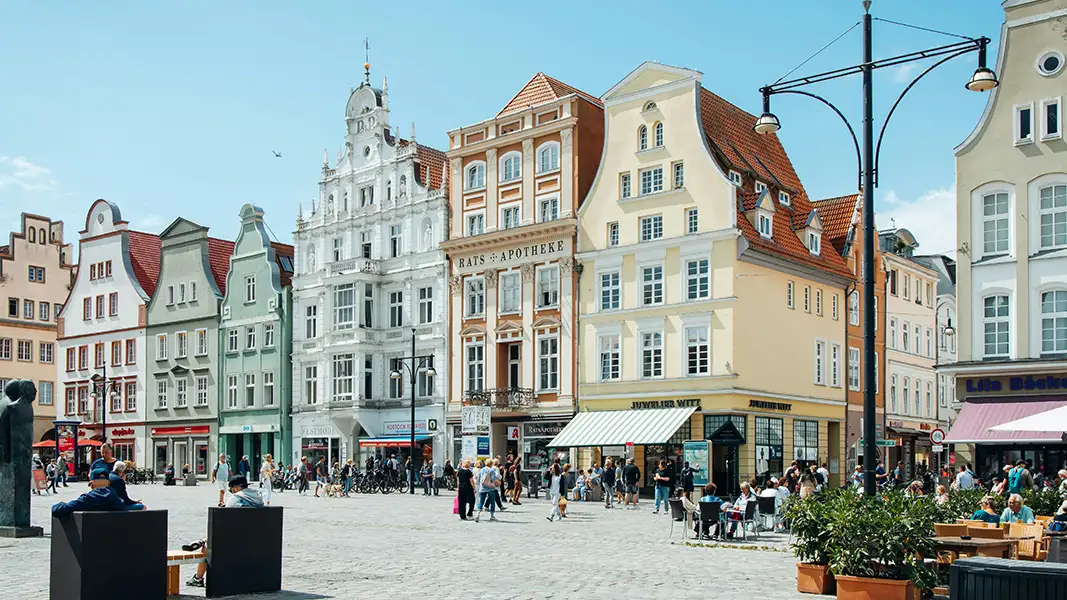Gedser - Rostock
Ferries to Germany
Gedser - Rostock
Ferries to Germany

Depending on the season their are usually 9 daily and 59 weekly sailings between Gedser and Rostock. Scandlines provides the ferry from Gedser to Rostock. Gedser Rostock ferries cost between $153 and $471, depending on ticket details. Prices exclude any service fees. Ferry timetables change seasonally, use our Deal Finder to get tickets, pricing, schedules and availability.
The earliest Gedser Rostock ferry typically departs Gedser at about 01:45 and the last ferry usually leaves at 22:30.
Ferries from Gedser to Rostock sail in around 2 hours. Ferry duration can vary by ferry provider and can be impacted by weather conditions.
There is 59 weekly sailings from Gedser to Rostock provided by Scandlines. Timetables can change from season to season.
The price of a ferry from Gedser to Rostock typically range between $153* and $471*. On average the Gedser Rostock ferry is $259*. The cheapest Gedser Rostock ferry prices start from $153*. The average price for a car is $260*.
Pricing will vary depending on number of passengers, vehicle type, route and sailing times. Pricing is taken from searches over last 30 days and exclusive of service fees, last updated December 25.
The distance between Gedser to Rostock is approximately 31 miles (50km) or 27 nautical miles.
Yes, Gedser Rostock ferries allow cars onboard with Scandlines between Gedser and Rostock. To view car ferry tickets and prices between Gedser and Rostock use our Deal Finder.
Currently foot passengers can not sail between Gedser and Rostock. Passengers must be travelling with a car.
Scandlines allow pets on ferries from Gedser to Rostock. Please also note that your pet may have to stay in the vehicle during the journey.
More routes than anyone else.

Compare fares, times & routes in one place.
Change plans easily with flexi tickets.

Book e-tickets & manage trips in-app.
Live ship tracking & real-time updates.

Top-rated customer support when you need it.
| Gedser - Rostock Ferry Route Summary | ||
|---|---|---|
| Departure Country | Denmark | |
| Destination Country | Germany | |
| No. of Operators | 1 | |
| Operators | Scandlines | |
| Average Price | $259 | |
| Average Daily Sailings | 9 | |
| Average Weekly Sailings | 59 | |
| Average Sailing Duration | 2 h | |
| Fastest Sailing Duration | 2 h | |
| First Ferry | 01:45 | |
| Last Ferry | 22:30 | |
| Distance | 27 Nautical Miles | |
* Prices subject to change, pricing is taken from last 30 days, last updated 1 December 2025.
Located at the southern end of the Danish island of Falster, in the Guldborgsund Municipality in Sjaelland region, the small town of Gedser is Denmark's southernmost town and has a population of around 760. As the town lies on the Baltic Sea coast, its port is very important in the area's economy. Infamously, Gedser was the first landing place of German troops during Germany's occupation of Denmark in 1940. A number of armoured cars and infantry troops hid in the ferry from Rostock and advanced into the harbour as soon as the ship docked, soon followed by another ferry.
The island on which Gedser is located, Falster Island, is in the south east of Denmark and forms part of the Sjaelland region and is administered by Guldborgsund Municipality. The island is home to Denmark's most southerly point, Gedser Odde, near Gedser.
A car ferry route has operated from Gedser to Rostock in Germany since 1995 and is operated by Scandlines. The crossing takes roughly 1 hour and 45 minutes.
The German city of Rostock is the largest city in the north German state of Mecklenburg-Vorpommern and lies around 12 km from the Baltic Sea coast, on the banks of the Warnow River. Founded in 1419, the city's university, the University of Rostock, is one of the oldest in Germany that has been in continuous operation and is also one of the oldest universities in the world. The university's botanical garden, the Botanischer Garten Universitat Rostock, is open to the public and is a lovely place to visit. Drawing on the city's maritime connections, Rostock is also home to the annual Hanse Sail Festival which is where you will be able to see many large sailing ships and museum vessels taken out to sea. The festival is very popular and attracts around 1.5 million visitors each year. Also hosted by the city is the annual jazz festival called Ostee-Jazz (Baltic Sea Jazz) and is held every June.
The city's port is one of the most important ports in Europe and is Germany's largest. Ferry services operating from the port depart to Gedser in Denmark (2 hours), Trelleborg in Sweden (5 hours and 45 minutes, with a super fast ferry travelling to Hanko in Finland with a crossing time of 22 hours.